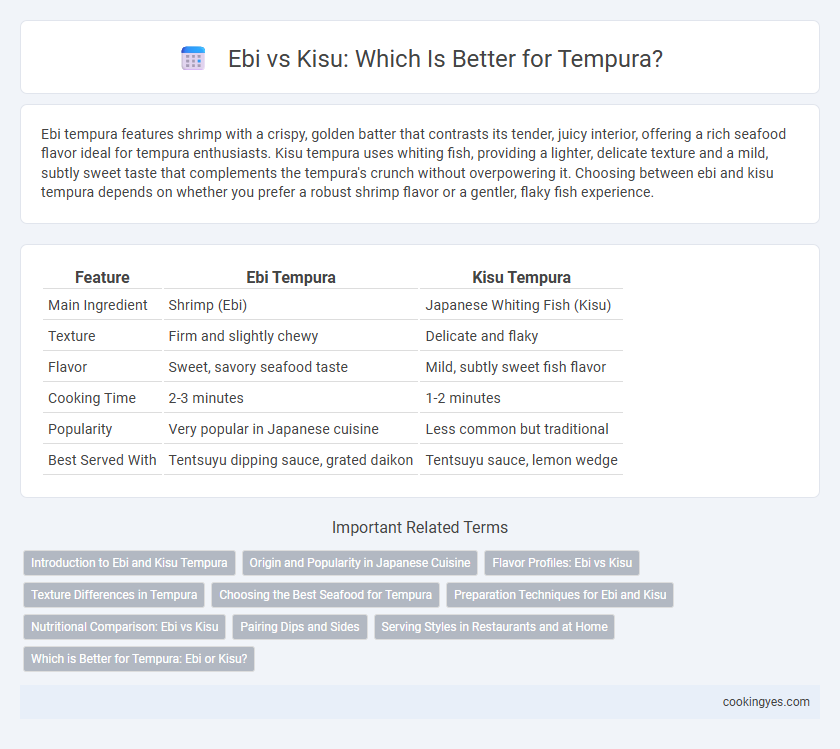Ebi tempura features shrimp with a crispy, golden batter that contrasts its tender, juicy interior, offering a rich seafood flavor ideal for tempura enthusiasts. Kisu tempura uses whiting fish, providing a lighter, delicate texture and a mild, subtly sweet taste that complements the tempura's crunch without overpowering it. Choosing between ebi and kisu tempura depends on whether you prefer a robust shrimp flavor or a gentler, flaky fish experience.
Table of Comparison
| Feature | Ebi Tempura | Kisu Tempura |
|---|---|---|
| Main Ingredient | Shrimp (Ebi) | Japanese Whiting Fish (Kisu) |
| Texture | Firm and slightly chewy | Delicate and flaky |
| Flavor | Sweet, savory seafood taste | Mild, subtly sweet fish flavor |
| Cooking Time | 2-3 minutes | 1-2 minutes |
| Popularity | Very popular in Japanese cuisine | Less common but traditional |
| Best Served With | Tentsuyu dipping sauce, grated daikon | Tentsuyu sauce, lemon wedge |
Introduction to Ebi and Kisu Tempura
Ebi tempura showcases plump, sweet shrimp coated in a light, crispy batter that enhances its natural umami flavor, making it a favorite among tempura enthusiasts. Kisu tempura features delicate Japanese whiting fish with a tender texture and subtle taste, providing a contrasting option to shrimp that highlights the versatility of tempura batter. Both Ebi and Kisu tempura exemplify traditional Japanese frying techniques, emphasizing freshness and balance in flavor and texture.
Origin and Popularity in Japanese Cuisine
Ebi tempura, made from shrimp, holds a prominent place in Japanese cuisine due to its delicate texture and sweet flavor, originating from coastal regions where shrimp is abundant. Kisu tempura, featuring Japanese sillago, is equally traditional, prized for its light and crispy bite, especially popular in Kansai, the western part of Japan. Both varieties reflect regional ingredient availability and have become staples in tempura dishes across Japan, celebrated for their unique taste profiles and cultural significance.
Flavor Profiles: Ebi vs Kisu
Ebi tempura offers a sweet, briny flavor with a firm, slightly chewy texture that complements the light, crispy batter perfectly. Kisu tempura delivers a delicate, mild taste with a tender, flaky texture, allowing the subtle natural sweetness of the fish to shine through. Comparing the two, Ebi tempura provides a more robust seafood flavor, while Kisu tempura emphasizes a gentle and refined taste experience.
Texture Differences in Tempura
Ebi tempura offers a firm, slightly chewy texture that contrasts with its crispy batter, providing a satisfying bite with each piece. Kisu tempura features a delicate, flaky texture that melts softly in the mouth, creating a light and airy experience. These distinct textural qualities distinguish Ebi's robust feel from Kisu's tender, almost ethereal crispness in traditional tempura dishes.
Choosing the Best Seafood for Tempura
Ebi (shrimp) and Kisu (Japanese whiting) are two popular seafood choices for tempura, each offering distinct textures and flavors that influence the final dish. Ebi provides a firm, juicy bite with a naturally sweet taste that complements the light, crispy tempura batter, making it a favorite among tempura enthusiasts. Kisu delivers a delicate, flaky texture with a mild flavor, ideal for those seeking a subtle seafood profile that absorbs the tempura batter's crunch without overpowering other ingredients.
Preparation Techniques for Ebi and Kisu
Ebi tempura requires meticulous deveining and tail cleaning to maintain texture and presentation, followed by a light batter dip that ensures a crisp, airy coating without overpowering the shrimp's natural sweetness. Kisu tempura involves careful filleting and deboning of the delicate Japanese whiting, with thin slicing to promote even cooking and a batter application that highlights the fish's subtle flavor and tender flesh. Mastering these preparation techniques enhances the overall tempura experience by balancing texture and taste specific to each ingredient.
Nutritional Comparison: Ebi vs Kisu
Ebi (shrimp) tempura offers a high protein content with approximately 24 grams per 100 grams, along with essential minerals like selenium and iodine, supporting immune function and thyroid health. Kisu (Japanese whiting) tempura is lower in calories and fat, providing about 19 grams of protein per 100 grams and rich in omega-3 fatty acids, which promote cardiovascular health. Both options are low in carbohydrates but differ in nutrient profiles, making Ebi suitable for higher protein needs and Kisu ideal for increased healthy fat intake.
Pairing Dips and Sides
Ebi tempura, known for its sweet and succulent shrimp, pairs excellently with a light tentsuyu dipping sauce made from dashi, soy sauce, and mirin, enhancing its delicate flavor. Kisu tempura, featuring the mild, flaky Japanese whiting, benefits from a slightly more robust tentsuyu or a yuzu-infused sauce to complement its subtle taste. Crisp daikon radish and grated ginger served as sides help balance the textures and intensify the dipping experience for both varieties.
Serving Styles in Restaurants and at Home
Ebi and Kisu serve distinct roles in tempura presentations, with ebi often featured as a centerpiece in restaurant dishes due to its visually appealing curled shape and succulent texture. Kisu, a type of whiting fish, is commonly served at home for a lighter, delicate tempura experience, showcasing its thin, flaky quality that pairs well with simple dipping sauces. Restaurants emphasize uniformity and aesthetic plating for ebi tempura, while home preparations favor kisu for ease and subtle flavor, reflecting different serving style preferences.
Which is Better for Tempura: Ebi or Kisu?
Ebi tempura offers a crunchy texture and sweet flavor that complements its firm, meaty bite, making it a popular choice for tempura lovers seeking richness. Kisu tempura, made from Japanese whiting, provides a delicate, mild taste with a light, flaky texture that crisps perfectly without overpowering the dish. Selecting between ebi and kisu tempura depends on preference for boldness versus subtlety, but both deliver the essential tempura qualities of light batter and fresh ingredients.
Ebi vs Kisu for Tempura Infographic

 cookingyes.com
cookingyes.com